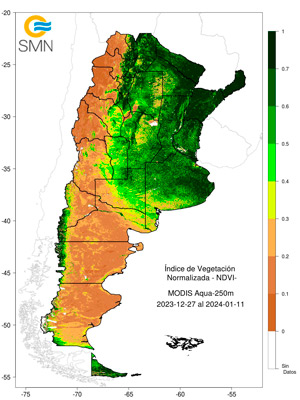HONEY MARKET IN ARGENTINA
LOW INTERNATIONAL PRICE EVEN IF THE RELATIVE PRICE IMPROVES
January 20th, 2024
 Versión en Castellano
Versión en Castellano (ESPACIO APICOLA, January 20th, 2024) Averaging the honey harvest in Argentina, production shows great contrasts between areas in which nothing was produced and others with high yields. The late rains and cold slowed down the beginning of the season in much of the most important beekeeping region of the country. The nectar flow season is expected to extend a little longer than usual.
(ESPACIO APICOLA, January 20th, 2024) Averaging the honey harvest in Argentina, production shows great contrasts between areas in which nothing was produced and others with high yields. The late rains and cold slowed down the beginning of the season in much of the most important beekeeping region of the country. The nectar flow season is expected to extend a little longer than usual.The NVDI Vegetation Index Map (photo) published by the National Meteorological Service for the first half of January clearly shows the response of the vegetation to the rainfall that began to become widespread in Argentina, from east to west, since last November on the Uruguay River and then covering, little by little, the entire arable and more strong beekeeping area of the country, although with a very significant delay in the west of Buenos Aires, Córdoba, La Pampa, among others. Of course, in the beehive's development, only young queen bees or some first-generation breeds or hybrids can accompany and take advantage of this shorter and later plant development; but even so, the population development of the most vigorous beehives does not come to emulate the performance of short-cycle crop varieties that are no longer planted in spring but at the beginning of summer, when soil moisture is sufficient and with forecasts encouraging, in a subtropical climate model that advances, due to deforestation and global warming, towards the south of the central region of the country.
The honey prices to the producer in Argentina are differentiated by color and also the conditions for certain types of honey have been adjusted today. The honeys are being paid to the producer in a range from $1,650 (Argentine pesos) per kilogram, for light honeys, and up to about $1,200 (Argentine pesos) per kilogram for dark honeys. These prices have a relative improvement with respect to the price of diesel (the main fuel used in cargo transportation) between 40 and 60% compared to the same relationship last November. However, the drop in international honey prices has left it behind the price of live steer. Historically, the ratio of honey/steer was 1 to 1 in kg when the meat was produced in the field, with pastures. After technological changes and the massification of feedlots for meat production, this ratio fell to 1.5 and even 2 to 1 ($kg Animal/Honey). Today in Córdoba the price of light wintering and rearing cattle is between $1700 to $1920 per kilogram according to a recent auction in Deán Funes (see here micro Ganados SRL) while in the Cañuelas market (Buenos Aires) the regular steer starts at $1200 and the heavy one is at $1600 per kg. after a price contraction caused by the fall in demand.
Returning to the honey market, today the people of Patagonik Food S.A. told us that the market is firm and that international contracts for batches composed of a mix of colors (below 34mm, up to 40 and up to 50mm Pfund) are being paid around USD 2,450 per metric ton and for batches of honey up to 65 and 75mm. Pfund USD 2000 per metric ton as long as they have a high F/G ratio. At the same time, the relative improvement of pollination services in fruit and vegetable provinces such as San Juan is between 30 and 40 dollars per beehive, which since the December devaluation implies an improvement since for now the increase in the Consumer Price Index (CPI) is 40% below the devaluation implemented by the current government.
Information generated by "Espacio Apícola" the Argentine Beekeepers' Magazine apicultura.com.ar

